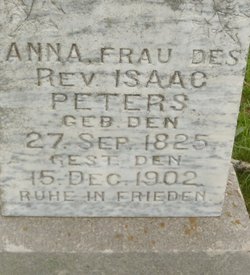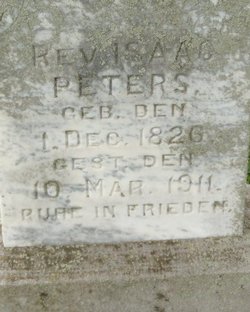 |
| Isaac G. Franz |
 |
| Anna Peters Franz |
 |
| Reverend Isaac Peters |
Grandma’s great-grandmother Anna Steingart (or Steingard or Steingardt) was born 27 September 1825 in the village of Pordenau, Molotschna colony (ca. 15 miles east of Kleefeld in the map here). She was married to Isaac Peters on 11 December 1849 and bore three children by him: Sara, Anna (pictured above; see here), and Isaac. She came to the U.S. on the voyage already mentioned in conjunction with her daughter Anna: the S.S. Vaderland, arriving with Isaac and her three kids in Philadelphia on 26 December 1874. She passed away on 15 December 1902, at the age of seventy-seven, and was buried in the Faith Evangelical Bible Cemetery, one-half mile south of the Henderson golf course.
Reverend Isaac Peters (the designation Reverend was apparently important to him, since it appears on his and his wife’s headstones), husband of Anna Steingart and great-grandfather to Malinda Franz Buller, was a man of some renown. Born on 1 December 1826 in Fürstenau, Molotschna (east of Tokmak in the northeast corner of the colony), he first became a teacher in Fürstenau (1850), then an ordained preacher (1866) and elder (1867) in the Pordenau congregation (the village where Anna was born) (see Epp 1959 for much of what follows).
One of his pupils, Peter M. Friesen, described him as a “stern and ironclad ‘old Mennonite’ in all questions of teaching and doctrine relating to society and the state, but also a man who realize[d] the value of a book, especially of historical and theological works. … [Peters] preached penitence and exercised church discipline in the strictest Mennonite sense.” Not everyone in Pordenau appreciated his commitments and teachings, and when a schism erupted in the church Peters and his adherents first were forced to withdraw and then were excommunicated from the congregation.
Peters was well known both for what he believed and what he denied. On the one hand, he rejected immersion as a mode of baptism (most Anabaptists poured water over the candidate’s head instead) and the doctrine of the millennium. On the other hand, he was fiercely committed to nonresistance, which led him to advocate loudly in favor of emigration when the possibility of Mennonites being called into the military arose in the early 1870s. His vocal support of emigration eventually led the Russian government to banish him, which led to his emigration to the U.S. at the end of 1874.
Once here, he and other members of his group joined the Bethesda Mennonite Church in Henderson, where Peters once again was appointed elder. By 1880, however, Peters became disgusted with lax standards of living and lack of discipline in that church, so he and his group withdrew to found a new church: Ebenezer Mennonite Church (organized 5 November 1882). The original church building was erected a mile south of Henderson, thus probably on the same site as the Faith Evangelical Bible Cemetery (aka Ebenezer Cemetery).
During Peters’s tenure as elder at Ebenezer Church (1882–1892) he helped form a new association: the Conference of the United Mennonite Brethren of North America. The conference name was later changed to Defenseless Mennonite Brethren in Christ of North America, then again to Evangelical Mennonite Brethren (EMB). Peters’s conference and church continue to exist, the latter with a new name (Faith Evangelical Bible Church) and a new location within the south part of Henderson (for a fuller account of EMB origins and Ebenezer’s history, see Epp 1953).
Isaac Peters passed away on 10 December 1911 and was laid to rest, not surprisingly, in the Faith Evangelical Bible Cemetery.

Sources
Epp, H. F. 1953. Historical Sketch of the Evangelical Mennonite Brethren Conference. Online here.
———. 1959. Peters, Isaak (1826-1911). Global Anabaptist Mennonite Encyclopedia Online.

No comments:
Post a Comment